Cosmos: An Interconnected Network of Blockchains Securing +$130bn of Assets
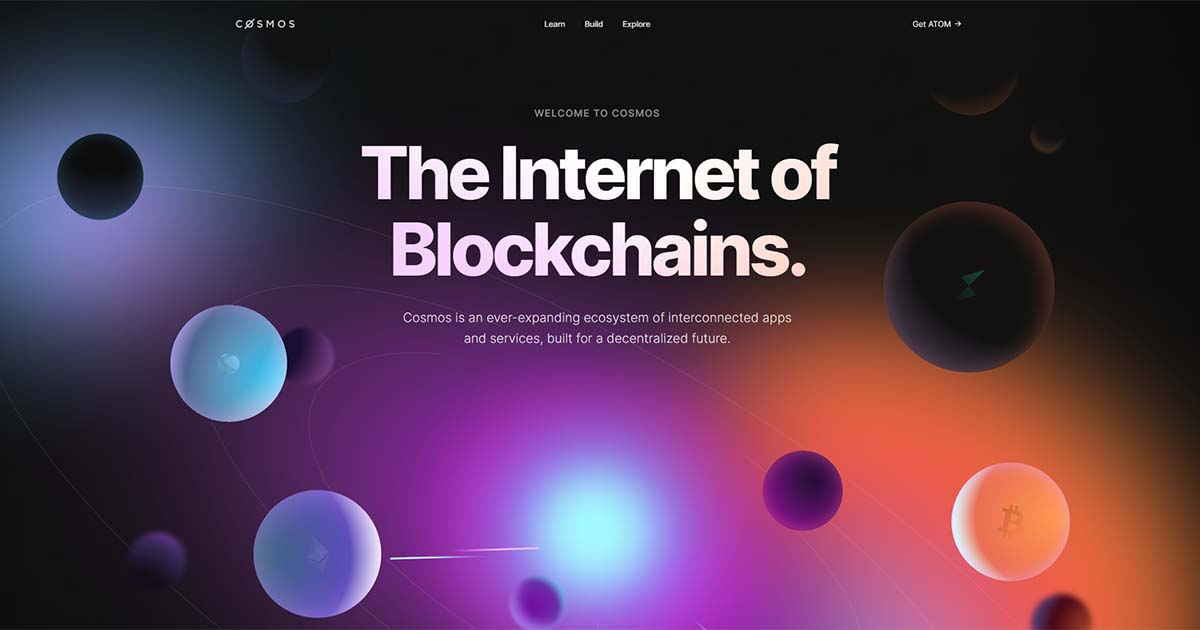
Disclaimer: Your capital is at risk. This is not investment advice.
Token Takeaway: ATOM;
In recent months, Cosmos ATOM has been one of the top performers, consistently scoring 5 stars on ByteTrend for multiple consecutive weeks, along with Cosmos ecosystem blockchain, Terra (LUNA). However, both are seeing a correction at present; after all, no assets are safe from the marketwide corrections. But, despite most Cryptocurrencies sitting 50%-70% below all-time highs, Cosmos ATOM is just 22.12% from its highs.
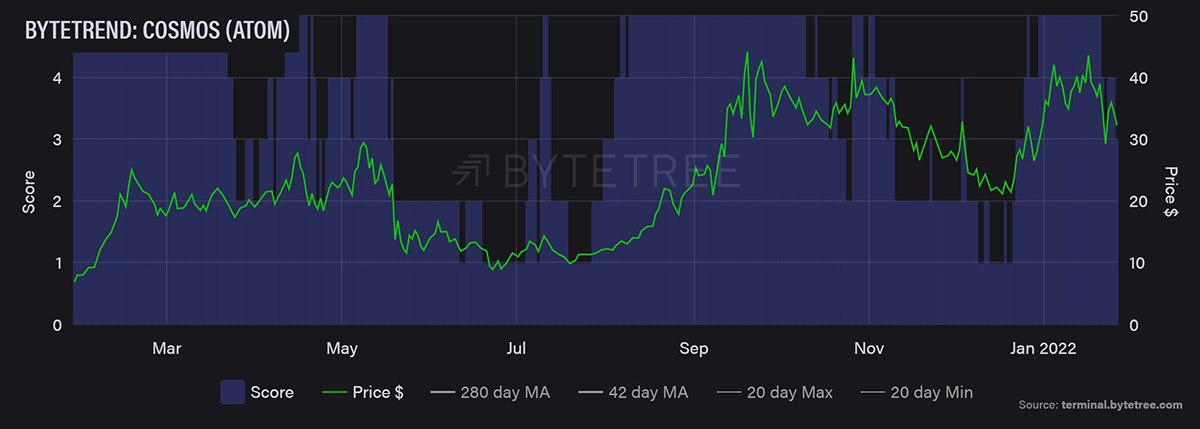
What is Cosmos?
“Cosmos” describes two things. The first is an ecosystem of connected blockchains, 30 at present, and expanding, all connected to one another via a generic bridge. The second is the Cosmos Hub, the first blockchain in the ecosystem, powered by the ATOM token.
It’s important to separate the two, so let’s start with the Cosmos ecosystem.
The Cosmos Ecosystem
Each Cosmos blockchain has its own team, developers, community, token model, application(s) and so on. Each chain is entirely independent and custom-built to service the needs of specific applications, or in some cases, generically built to power ecosystems. However, what they all have in common is that they are all built with the Cosmos technology stack - a group of technologies that allows a developer to quickly and easily deploy a custom blockchain ready to interoperate within the Cosmos ecosystem.
Some chains may utilise smart contracts to host multiple applications (such as Terra), whilst other chains may be application-specific, i.e. built to specifically serve the needs of a specific type of application, such as an exchange or a metaverse world. These blockchains are collectively known as the Cosmos ecosystem. They include blockchains and tokens such as Cosmos (ATOM), Terra (LUNA), and Osmosis (OSMO).
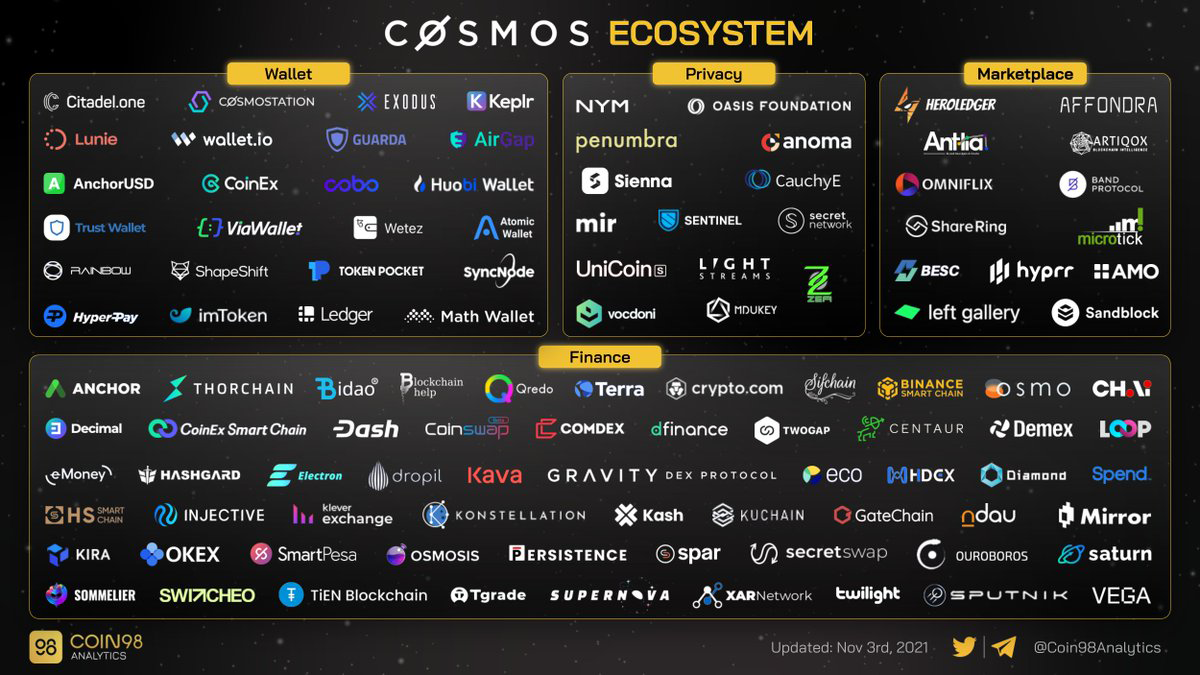
Tendermint Consensus Engine
Consensus is how a blockchain is secured. Bitcoin and Ethereum use a proof-of-work algorithm, while most new blockchains use proof-of-stake, which is around 10,000 times more energy efficient. Tendermint Consensus is a specific variation of proof-of-stake that all Cosmos Ecosystem chains use and is the most widely adopted Consensus mechanism in the Cryptocurrency ecosystem. Binance Smart Chain and Polygon are also examples of chains that have adopted the Tendermint Consensus by forking the code.
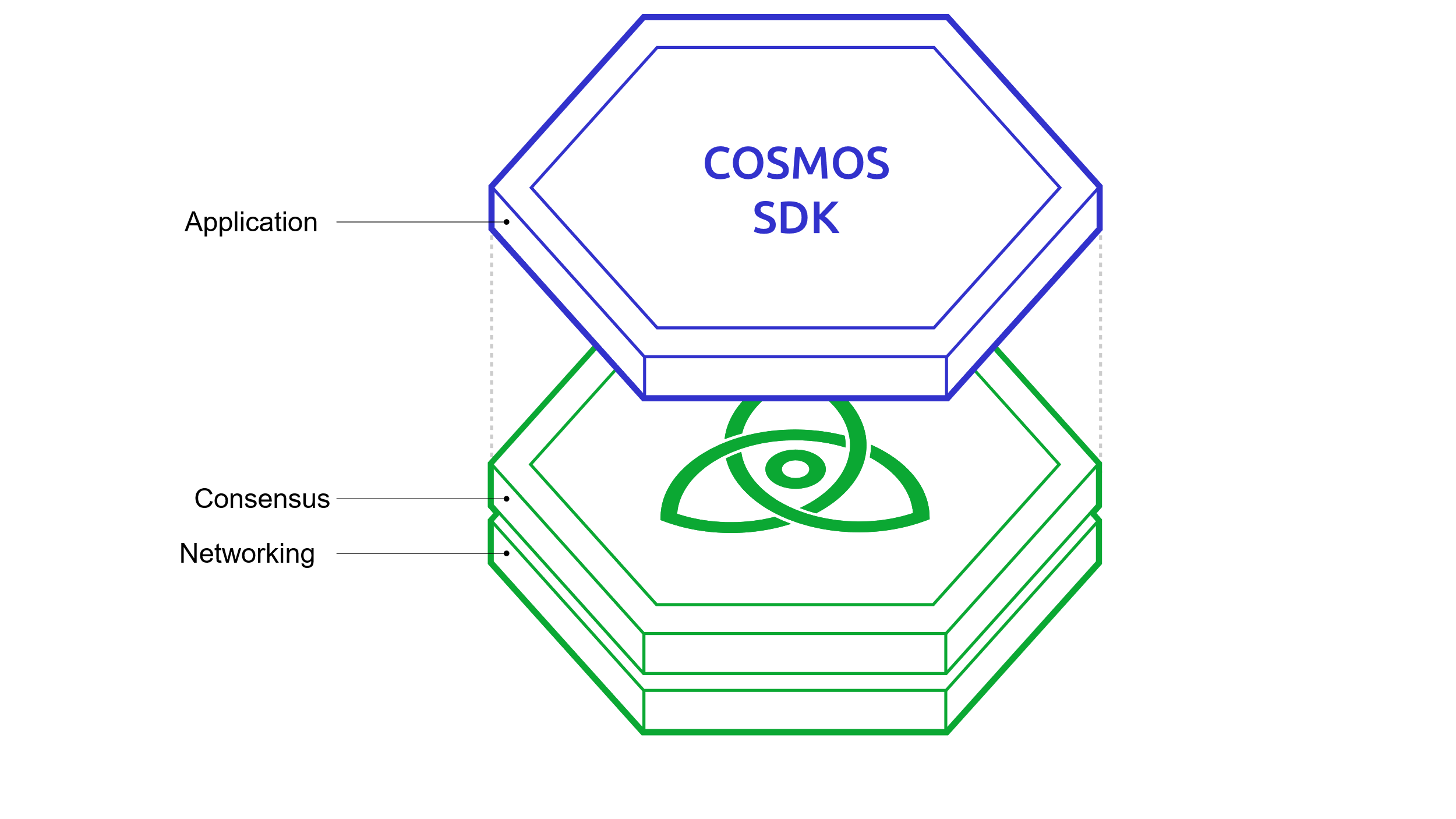
Cosmos Software Development Kit
Software Development Kits (SDK) are collections of tools that facilitate the creation of applications. The Cosmos SDK is a collection of tools that facilitates the creation of a custom blockchain. These allow developers to easily deploy their custom, independent chain with parameters optimised for hosting particular application(s) within the Cosmos ecosystem. Starport is a platform that incorporates the Cosmos SDK to provide everything developers need to build, launch and maintain their blockchain.
The Tendermint consensus engine and the Cosmos SDK provide the foundations for creating an ecosystem of multiple blockchains by reducing the time required and removing the barriers to new blockchains entering the ecosystem.
Inter-Blockchain Communication Protocol
What if I told you that in the future, all blockchains would be connected to one another via huge data highways, much like the highways that exist between cities and towns, and that by creating these highways, the value and transactional activities of these blockchain economies would increase exponentially? Now, what if I told you that this is already being realised within the Cosmos Ecosystem? The cluster of independent, sovereign blockchains are built with the same and connected via a standardised data highway called the Inter-Blockchain Communication Protocol, or IBC for short.
These data highways are generic, allowing connection between any two chains built within the Cosmos ecosystem. A little tweaking will even allow connection to chains beyond the Cosmos technology stack, including proof-of-stake chains like Avalanche or Polkadot. These ‘data highways’ have processed over 4 million transactions between blockchains over the last 30 days alone.
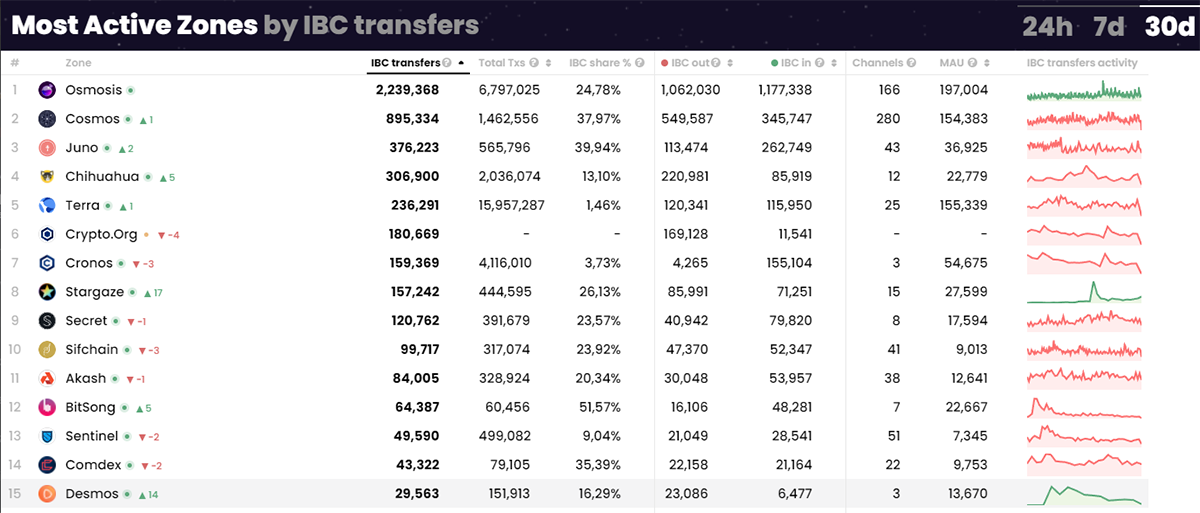
Network Effects - Metcalfe’s Law
A network effect describes a situation where the value of a product, service or platform becomes more valuable as the number of users increases. In technologies such as communications networks or the internet, this is extremely powerful as an increase in connected users results in an exponential growth in the number of connections, which leads to an exponential growth in a network’s value.
A simplified description of this is Metcalfe’s Law, which states “the value of a network is proportional to the square of the number of its users”.

This is where the Cosmos ecosystem comes into its own. The Tendermint Consensus and the Cosmos SDK allow for low barrier entry for new blockchains to the network. Each chain can attract its own user base and benefit from its own internal network effect. Inter-blockchain communication through IBC is where the real magic of a network effect takes place. IBC creates a cross-blockchain network of users, which increases the value of each network connected to one another via the bridge (data highways).
The Cosmos Hub
The second thing that Cosmos describes is the Cosmos Hub - the first independent, sovereign blockchain in the Cosmos ecosystem. It was created by one of the teams who contributed to the development of Cosmos technology that the broader ecosystem uses today. Like other Cosmos chains, the Cosmos hub is secured by Tendermint Consensus and connected to the IBC protocol. It is responsible for the second-highest number of cross-chain transactions by any chain in the Cosmos ecosystem over the last 30 days.
ATOM
The Cosmos Hub’s native token is the ATOM token, which has a market capitalisation of $10bn, according to CoinGecko. ATOM acts as a governance token allowing community members to vote on proposals about the Hub’s future. Holders can stake ATOM to secure the chain and earn staking rewards. Current rewards rates can be tracked at stakingrewards.com.
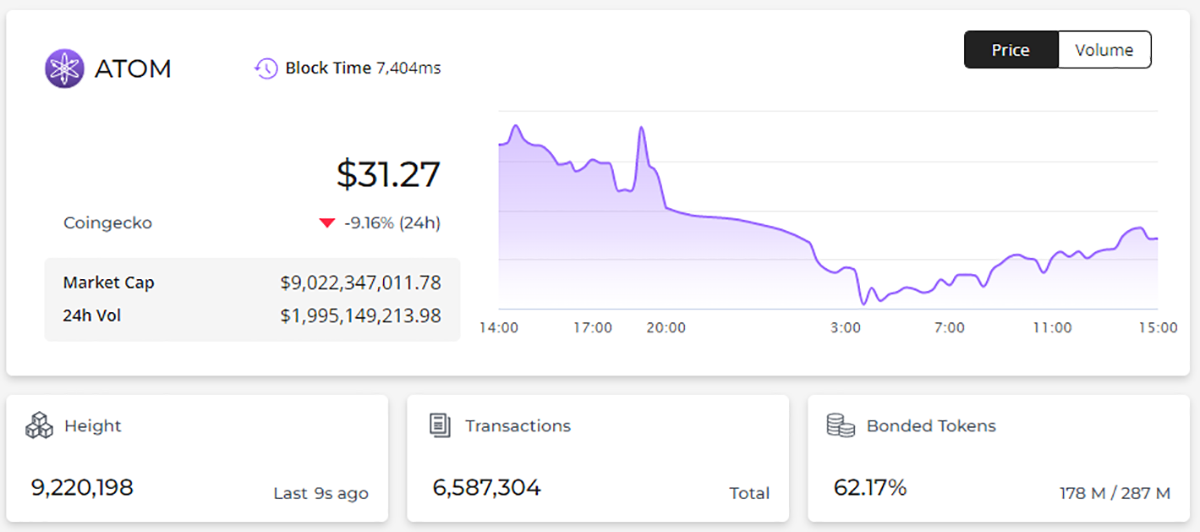
Over the last year, the ATOM token has drawn criticism on account of its non-fixed supply. The supply increases 7-20% a year due to new token emissions, which reward stakers securing the chain. The community DAO (Decentralised Autonomous Organisation – essentially the community that determines how the blockchain moves forward) has been heavily engaging around the ‘runaway inflation’ caused by these emissions - changes will likely be made in the future.
A second criticism has been ATOM’s limited utility beyond staking and governance. Improvements to its utility are expected to come this year, with upgrades coming to the Cosmos Hub, including interchain accounts, liquid staking, and a very promising upgrade - Interchain Staking.
Interchain staking will allow the Cosmos Hub to offer security to blockchains in the Cosmos ecosystem by leveraging the staked ATOM securing the Cosmos Hub chain. Consequently, this provides utility to the ATOM token and brings a financial reward to those staking their tokens.
ATOM also accrues value from airdropped tokens given to ATOM holders by aspiring blockchains in the ecosystem. The Cosmos Hub has a strong community built around it, and new blockchains can onboard Cosmos Hub users into their own community by airdropping their native token to ATOM holders or stakers.
High-value airdrops have already taken place, including from Osmosis - the leading exchange in the Cosmos ecosystem, valued at $2.47bn. A more recent airdrop from Stargaze, a recently launched Cosmos blockchain, saw around $150m worth of tokens claimable for Cosmos communities.
Because of these airdrops, the Cosmos branding and the Cosmos Hub focus on providing services to the Cosmos ecosystem, such as Interchain Staking. Arguably, the ATOM token is still best positioned to give investors exposure to the growth of the entire ecosystem. However, ATOM’s value and the growth of the ecosystem are not directly aligned at this time.
Summary
Cosmos is an ecosystem of blockchains that offer value from the perspective of sovereignty, customisation and interoperability. It offers one of the best tech stacks available to developers in the market.
The Cosmos Hub is the blockchain that powers the ATOM token, one of the largest cryptocurrencies in the market. The utility of the ATOM token is also poised to increase with future network upgrades.
Cosmos network growth and the value of the ATOM token are not fully aligned at present. The Cosmos Hub and ATOM are well-positioned to service ecosystem blockchains. With the Cosmos brand exposure, ATOM still offers investors the best opportunity to get exposure to the success of the broader ecosystem.
The Cosmos ecosystem is likely to continue to grow as interconnected blockchains get the benefit of a network effect on steroids. The trend has been strong, and all the tools are there to allow easy access for new projects to enter the ecosystem.
This article was written by Liam Connor from Confident in Crypto. Follow him on Twitter and YouTube.

Comments ()